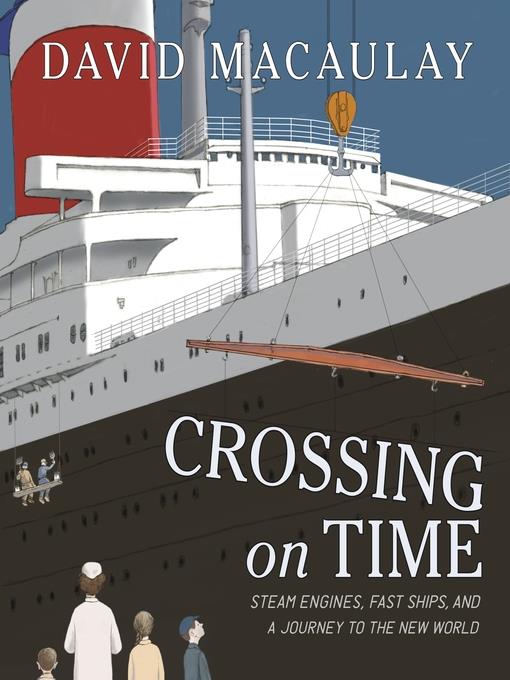
Crossing on Time
Steam Engines, Fast Ships, and a Journey to the New World
فرمت کتاب
ebook
تاریخ انتشار
2019
Lexile Score
1200
Reading Level
6
ATOS
7.7
Interest Level
4-8(MG)
نویسنده
David Macaulayناشر
Roaring Brook Pressشابک
9781250261588
کتاب های مرتبط
- اطلاعات
- نقد و بررسی
- دیدگاه کاربران
نقد و بررسی

March 25, 2019
More than 30 years after the publication of The Way Things Work, Macaulay continues to amaze with his architect-trained eye for detail and ability to make the complex understandable. His latest demystifies steam power and its use in ships through the mid-20th century. Bookending the steamship chronicle is the story of the author’s boyhood immigration from Great Britain to the U.S. in 1957 aboard the fastest transatlantic passenger steamship at the time, the SS United States. After delving into the mechanics of steam power, the narrative introduces naval architect William Francis Gibbs and details construction of Gibbs’s dream ship—the same one that carried the author to his new home. The final of four chapters recollects his family’s ocean crossing. Macaulay’s trademark diagrammatic illustrations, with varied perspectives, cross-sections, explanatory captions, and a dose of subtle humor, offer a multilayered reading experience. Particularly impressive is a massive gatefold that offers a stunning bow-to-stern cutaway of the SS United States. A timeline, selected reading list, and archival photos accompany an afterword that entreats that “we must look back ... to see where we’ve been and to be reminded of our accomplishments,” as it discusses a conservancy’s efforts to preserve the historic vessel. Ages 10–14.

March 15, 2019
Childhood memories, as well as loads of historical and archival research, anchor a history of ocean liners from the invention of steam pumps to the magnificent SS United States.Linked by recollections of his own family's 1957 journey from the U.K. to New York aboard the United States, Macaulay traces the development of steam-powered ships from a small 1783 paddle-driven experiment to the 990-foot monster that still holds the record for the fastest Atlantic crossing by a ship of its type. Ignoring the Titanic-like tragedies, he focuses on design and engineering--mixing profile portraits of dozens of increasingly long, sleek hulls with lovingly detailed cutaway views of boilers, turbines, and power trains, structural elements being assembled (sometimes with the help of a giant authorial hand reaching down from the skies), and diagrams of decks and internal workings. All of this is accompanied by sure, lucid explanations and culminates in a humongous inside view of the United States on a multiple gatefold, with very nearly every room and cupboard labeled. Having filled in the historical highlights, the author turns to his own story with an account of the five-day voyage and his first impressions of this country that are made more vivid by reconstructed scenes and family photos. A waiter in one of the former is the only person of color in clear view, but human figures of any sort are rare throughout.Personal notes give this stirring tribute to speed, power, and technological prowess an unusually intimate air. (timeline, further reading) (Nonfiction/memoir. 11-14)
COPYRIGHT(2019) Kirkus Reviews, ALL RIGHTS RESERVED.

Starred review from May 1, 2019
Gr 6 Up-An in-depth informational text surveying the history of steamships, focusing on the SS United States. Master author/illustrator Macaulay combines expository and narrative nonfiction, explaining how William Francis Gibbs and his brother engineered the building of the SS United States and how his family eventually immigrated to America journeying on that very ship. The author's personal connection provides a solid foundation for the information. Macaulay's beautifully detailed illustrations illuminate the blended text, and are so engaging that they will draw in readers otherwise reluctant about the content of the book itself. An afterword and time line provide back matter that will further round out the readers' experience. VERDICT This book is a necessary addition to any collection serving middle grade readers and is perfect for collections in need of STEAM texts; a must-buy for any and all collections.-Amy McInerney, Falmouth Elementary School, ME
Copyright 2019 School Library Journal, LLC Used with permission.

Starred review from April 15, 2019
Grades 4-8 *Starred Review* Macaulay's nonfiction has enlightened many of us, explaining topics from architectural wonders to household gadgets to the human body in his classic The Way Things Work (1988). Here he offers a somewhat personal glimpse at oceanic vessels and the steam engines that powered them. In 1957, 10-year-old Macaulay and his family emigrated from Britain to the U.S., traveling on the SS United States, the fastest steamship of the day. Macaulay treats readers to a history of steam engines (and their many improvements), leading up to a detailed account of the construction of the United States, designed by engineer William Francis Gibbs. Macaulay's succinct, explanatory text propels the narrative, drawing readers into his meticulous, captioned artwork that further clarifies the discussion. The illustrations are varied (cutaway views, aerial perspectives, spot art, and full-page spreads) and often depict the artist's hand at work: building models, executing a drawing, and lifting the page to remind readers of the Macaulay family. The most amazing spread is a triple gatefold depicting the entire ship, featuring both cutaway and exterior views. Juicy tidbits (the ship was outfitted with an operating room, a morgue, and seven caskets) augment scientific and historical details, and Macaulay's memories of his own voyage add a child's perspective. Appended with an afterword, time line, and photos, this is not to be missed.(Reprinted with permission of Booklist, copyright 2019, American Library Association.)

























دیدگاه کاربران